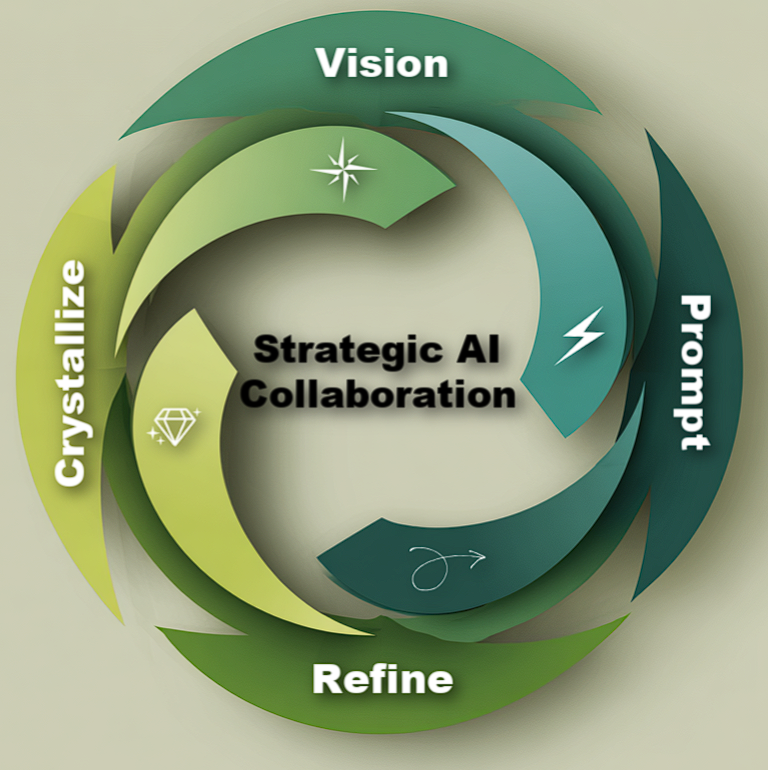PAIR Methodology
Prompt Architecture with Iterative Refinement
The comprehensive approach to AI-powered software development that transforms how teams build, iterate, and deliver exceptional software.
The PAIR Framework
Four foundational pillars that guide AI-enhanced development from vision to delivery.
Strategic design of AI interactions through structured communication patterns and vision-driven development.
Architecture-primary development where system design emerges through iterative refinement, treating early code as experimental.
Continuous refinement cycles with clear decision points for when to refine versus restart completely.
Systematic optimization through feedback loops, role-based collaboration, and intelligent pattern recognition.
PAIR Development Roles
Clear role definitions that maximize team effectiveness and AI collaboration.
- Owns the architectural vision and strategic requirements
- Maintains system coherence across development cycles
- Decides when to refine vs. restart based on architectural evolution
- Communicates intent clearly to guide AI interactions
- Translates vision into effective AI prompts
- Guides and refines AI generations through structured interactions
- Recognizes when prompts need fundamental restructuring
- Develops reusable prompt patterns for consistent results
- Validates generated code against architectural goals
- Ensures testing and quality standards are maintained
- Identifies warning signs that indicate restart is needed
- Oversees integration and system-wide quality
The Complete PAIR Cycle
A systematic four-phase approach to AI-enhanced development.

Architectural Visioning
- • Develop comprehensive mental model of system architecture
- • Define core business logic and data flow patterns
- • Establish quality criteria and success metrics
Capability Assessment
- • Evaluate team capabilities and technical constraints
- • Identify optimal AI tool selection and integration
- • Plan documentation framework and workflows
Strategic Prompting
- • Translate architectural vision into AI-friendly prompts
- • Communicate intent and outcomes, not implementation
- • Design systematic prompt patterns for consistency
Experimental Code Generation
- • Generate working implementations using proven patterns
- • Validate outputs against architectural vision
- • Test assumptions early and frequently
Continue Refinement When:
- • Architecture remains stable and clearly defined
- • Code quality improves with each iteration
- • System complexity remains manageable
Execute Strategic Restart When:
- • Architecture has evolved significantly
- • Code becomes fragile despite improvements
- • Iteration cycles produce diminishing returns
Convergence Recognition
- • Architecture and implementation achieve alignment
- • Code quality meets all established standards
- • System demonstrates extensibility
Knowledge Capture
- • Document proven architectural patterns
- • Create reusable prompt templates
- • Establish team best practices
PAIR Decision Framework
Clear indicators to guide critical development decisions.
- • Fundamental architectural evolution
- • Persistent code fragility
- • Declining prompt effectiveness
- • Mental development constraints
- • Quality degradation pattern
- • Exponentially increasing complexity
- • Test suite brittleness
- • Team frustration and reduced confidence
- • Architectural performance issues
- • Consistent quality improvement
- • Stable architecture
- • Effective prompt patterns
- • Strong team confidence
PAIR Success Outcomes
Measurable benefits organizations achieve through PAIR methodology adoption.
- • Dramatically faster alignment between design and product
- • Consistently cleaner, more modular architectures
- • Significant reduction in technical debt
- • Enhanced developer intuition for AI collaboration
- • More confident architectural decision-making
- • Improved team collaboration through clear roles
- • Enhanced problem-solving efficiency
- • Stronger pattern recognition capabilities
- • Reduced overall development cycles
- • Consistently higher code quality
- • More maintainable and extensible systems
- • Faster feature delivery through proven patterns
Getting Started with PAIR
A structured approach to implementing PAIR methodology in your organization.
• Evaluate current development practices and team capabilities
• Identify optimal AI tool compatibility and integration opportunities
• Train team members on PAIR principles and role-based collaboration
• Establish documentation frameworks and measurement systems
• Select appropriate pilot project with suitable scope
• Apply complete PAIR methodology with designated roles
• Monitor and measure results against success criteria
• Refine organizational approach based on pilot learning
• Expand PAIR adoption to additional projects and teams
• Develop advanced organizational expertise
• Create institutional pattern libraries and documentation
• Establish continuous improvement processes